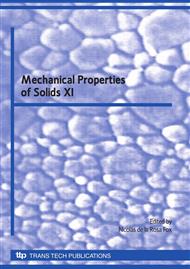p.105
p.113
p.119
p.125
p.131
p.137
p.147
p.155
p.161
Creep Behaviour of Closed Cell Aluminium Foams from Stress Relaxation Tests
Abstract:
Creep behaviour of closed cell aluminium foams and transitions from power law to power law breakdown (PLB) creep regimes are investigated from results of stress relaxation tests (SRT) carried out on Alporas foams with densities between 0.20 to 0.32 g/cm3. Tests were carried out at temperatures between 200°C and 300°C and stress relaxation was measured from the collapse stress under compression of the foams. Under similar foam density, temperature and stress conditions, the values of strain rate calculated from SRT tests were of the same order of magnitude than those previously reported in the literature from conventional constant load creep tests. Under stress values close to the collapse stress, the creep mechanism seems to follow a PLB regime, with values of the power law exponent n=10-17, much higher than those corresponding to the power law creep in the solid material (n=4.4-6.5) and with activation energy values close to Q = 150 KJ/mol. Having in mind the limitations of available creep models for closed cell foams and the need for additional experimental results, the use of SRT testing would offer advantages for the assessment of the high temperature behaviour of aluminium foams, due to its lower testing times and reduced experimental effort.
Info:
Periodical:
Pages:
131-136
Citation:
Online since:
December 2009
Authors:
Keywords:
Price:
Сopyright:
© 2010 Trans Tech Publications Ltd. All Rights Reserved
Share:
Citation:


